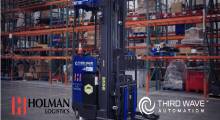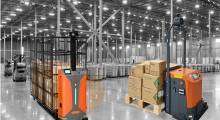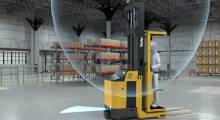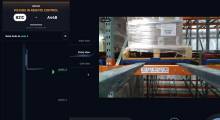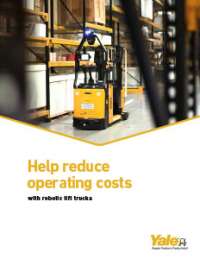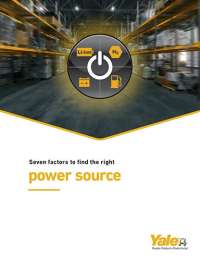According to the Oxford English Dictionary, the term “reliant” is an adjective that means “dependent on someone or something.”
Let’s flip that around. How about if someone - say an operations manager in a warehouse - is depending on something Reliant to not let a truck hit anything.
Enter Yale Lift Truck Technologies’ Reliant operator assist system and autonomous lift truck lineup.
Lidar keeps humans safe and vehicles in motion
With both Reliant and the autonomous vehicles from Yale, lidar plays an integral role in object detection, precise movements and safely navigating the potential hazards of the warehouse.
“From an object standpoint, we are utilizing a lidar-based technology,” said Joe Koch, sales manager, emerging technology, operator assist systems and telematics at Yale. “It's constantly scanning at about 170 degrees at about 30 feet. But there's a certain buffer zone that we put in there for the system to actually target a controlled slowdown. But with that 170 degrees, we're actually calculating the algorithm to the width of the truck.”
As Reliant constantly scans the lift truck’s surroundings, it’s not only looking for objects in the lift truck’s path, but also running advanced computations to continue safely moving the vehicle and its load without tipping or creating another dangerous scenario.
“It all sounds simple in concept, but all of these factors are actually playing in with our advanced dynamic stability in the moment,” Koch said. “We're calculating the center of gravity and each input that you have, each stage that you're in, for your mass, the tilt, the weight, your travel direction, your speed, your acceleration. It will all be tailored into how that truck reacts in real time with the operator - no matter what they're doing from an input standpoint - as they're utilizing that truck for a different controlled slowdown each and every time. We're not throwing a load, we're controlling that load, we're controlling the truck, we're controlling stability, but we're not hindering the operator from doing anything either.”
On the autonomous lift truck side, the main focus of the lidar sensors on the vehicles is object detection in the primary directions of travel.
“Any fork autonomous solution is going to be able to move a full 360-degree direction forward, reverse and left to right,” said Kyle Smart, sales manager, emerging technology, robotics and automation at Yale. “And it's going to have fields of view displayed accordingly.”
What slows the vehicles down?
Lidar, as Smart described, is a consistent and reliable technology that Yale utilizes across its offerings for safety and precision.
“In terms of lidar versus some of the other technology out there, from the autonomous standpoint, lidar just continues to be really one of the most reliable and robust safety mechanisms in the industry,” Smart said.
Koch agreed.
“Lidar, for where the market currently is in a technology standpoint, it is more feasible, it's more reliable and it's more consistent in its detections,” he said. “It's not looking at, ‘Hey, is this a human shape, or is this going to cause a false detection?’ It can see a cone and it looks like someone is crouching, or a ladder looks like someone is standing up. From an operator assist standpoint, it takes a lot for us to be able to validate and put that onto our vehicles, whereas lidar is like a plug and play once you get the algorithm in there.”
However, elements present in the warehouse can slow down lidar - along with cameras and sensors - on these vehicles. Stretch wrap, dark colors, low-light areas and items under three-quarters of an inch in diameter are elements that Koch and Smart described as somewhat tricky for lidar to comprehend, but the Yale systems and vehicles are able to navigate safely in and around these areas.
CAD layouts, pictures get the system going
When customers come to Yale exploring autonomous lift truck options, the start of a project begins with a CAD layout.
“A CAD gives us a number of things,” Smart said. “It gives us the ability to determine the size of the space we're going to operate in, to measure our aisles, our turning radiuses where we need to pivot at, where we're manipulating the loads. Do we have any general space constraints?”
After that, some simple pictures really start expediting the project.
“Then it's going to be what is the size and the weights of the loads we need to move in that project,” Smart added. “A lot of times, pictures are worth 1,000 words.”
Reliant never stops, just crawls
On the operator assist side of the equation, Reliant’s constant scanning of the lift truck’s surrounding area creates a standard buffer zone to slow down the vehicle around anything it detects as a possible hazard.
“The standard buffer zone of about three meters is when we start slowing down the truck, even though we're looking out 30 feet to predict the path of travel,” Koch said. “Once it hits that three-meter threshold, it'll start bringing down that speed depending on that load that's on there, the direction of the truck and the speed of travel currently.”

Another safety element that Yale is mindful of involves regulations - at the state, United States and/or European Union level - of the vehicle’s movement.
“As the lift trucks approach the buffer zone, they will just go to a crawl at 1.5 miles per hour,” Koch said. “The operator still has control of the vehicle at all times. We never bring it to a stop, which is key, because there's just states that you're not allowed to stop the vehicle. Operators remain in control.”
With the entirety of the Yale ecosystem, one thing encompasses all the various offerings, from the manual forklifts the company has produced for over a century, to the technologically advanced autonomous lift trucks and Reliant operator assist system- precision is key.
“Precision is critical,” Smart said. “Navigational accuracy and the tolerance that lidar provides is critical. Using some of the other sensor technology on the vehicle, we can overcome some of the tolerances that exist with all aspects of technology that the vehicle's equipped with in terms of speed and safety that we're maintaining around racks, other equipment or things that are just in the environment. They are all going to directly correlate to each other.”
Want to learn more about machine vision? This article was featured in the August 2024 Robotics 24/7 Special Focus Issue titled “Machine vision to increase robot precision.”
About the Author
Follow Robotics 24/7 on Linkedin
Article topics
Email Sign Up




